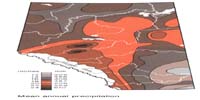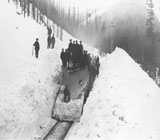Climate and Weather
The severity of the winter of 1906–7, the worst in a quarter of a century, proved difficult for railways, as intense cold and drifting snow hampered, and in some cases stopped, trains from carrying supplies to communities, thus imposing hardship on everyone. Even in the spring it took a Canadian Northern train 18 days to travel from Winnipeg to Edmonton.1 In 1951 a passenger train was almost buried by snow at Oyen.2
In 1935 torrential rains, melting snow and gale force winds caused flooding along the south shore of Lesser Slave Lake causing extensive damage to the track of the Northern Alberta Railways.3 Further along the line mudslides occurred at East Smoky Hill, and the bridge approaches at the Smoky River were partially washed away.4
Blowing sand posed a problem for the Grand Trunk Pacific’s line running on the east side of Brûlé Lake.5
Alberta’s changing weather and other instances of the adverse impact of climate on railway operations remind railway companies to be ever vigilant.
Notes | Bibliography | Abbreviations
1. Canadian Annual Review, 1907, p. 141.2. Canadian National Railways, Annual Report, 1951.
3. Ena Schneider, Ribbons of Steel (Calgary: Detselig, 1989), p. 159.
4. Ibid., p. 166.
5. H.A. Parker, Report on the Mountain Section, GTP. July, 1909, p. 18.31; “The Energy Question,” Energy Options, Ottawa.

